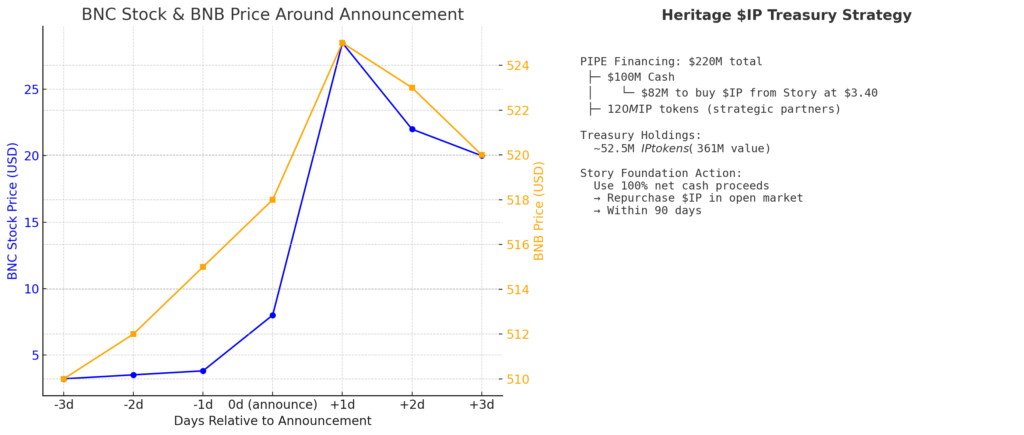
Key Highlights:
- CEA Industries (now Nasdaq: BNC) acquired 200,000 BNB (~$160 million), becoming the largest corporate BNB treasury.
- The treasury move was funded via a $500 million PIPE led by 10X Capital and YZi Labs, with potential to expand to $1.25 billion via warrants.
- BNC restructured its leadership—appointing David Namdar (Galaxy Digital) as CEO among others.
- BNB ranks as the 4th-largest cryptocurrency, with $12.3 billion in TVL and ~250 million users.
- Heritage Distilling (Nasdaq: CASK) launched a $220 million IP‑token (Story’s $IP) treasury strategy, allocating $82 million to buy $IP at $3.40 each.
- Heritage’s treasury will hold ~52.5 million $IP tokens worth ~$361 million; Story Foundation will use cash proceeds to repurchase $IP in the open market within 90 days.
- These moves mark strategic shifts: digital assets as active, yield‑oriented reserves for publicly traded firms.
Section 1: BNC’s Bold Pivot to BNB Treasury
In a decisive departure from its origins as a nicotine vape producer, CEA Industries—now trading under the Nasdaq ticker BNC—has embraced a crypto‑first treasury strategy. On August 10, 2025, the company’s treasury arm, BNB Network Company, announced the acquisition of 200,000 BNB tokens, totaling approximately $160 million—making it the largest corporate holder of BNB globally.
This bold move was funded through a $500 million PIPE private placement, spearheaded by 10X Capital in partnership with YZi Labs, a Binance-linked investment firm. The company plans to continue acquiring BNB until its initial treasury funds are fully deployed and may raise up to $750 million more through warrant exercises—potentially bringing total BNB purchases to $1.25 billion.
In line with its strategic pivot, CEA changed its Nasdaq ticker from VAPE to BNC and reorganized leadership: David Namdar (co‑founder of Galaxy Digital) as CEO, joined by Russell Read (ex‑CIO of CalPERS) and Saad Naja (former Kraken director), along with two members from 10X Capital.
Why BNB?
BNB, the native token of BNB Chain, ranks as the 4th‑largest cryptocurrency by market capitalization, with over $12.3 billion in TVL (Total Value Locked)—making it the 3rd largest blockchain by TVL—and boasting around 250 million users and $9.3 billion average daily trading volume as of mid‑2025. The token’s appeal hinges on deflationary token burns, expanding on‑chain activity, and potential for a BNB spot ETF, positioning it as a compelling long‑term institutional reserve asset.
Section 2: Heritage Distilling Adopts Story’s IP Token as Reserve
Meanwhile, on August 11, 2025, Heritage Distilling Holding Company (Nasdaq: CASK) announced a groundbreaking digital‑asset treasury strategy centered on Story blockchain’s native token, $IP.
Through a $220 million PIPE financing—consisting of $100 million cash and $120 million in $IP tokens contributed by Story Foundation and strategic partners—Heritage plans to allocate $82 million to purchasing $IP from the Story Foundation at a fixed price of $3.40 per token.
By closing, Heritage’s treasury is expected to hold approximately 52.5 million $IP tokens, valued at around $361 million based on the August 10 price of ~$6.8785 per token. The Story Foundation, in turn, commits to using 100% of the net cash proceeds to repurchase $IP tokens in the open market within 90 days, supporting stability and aligning incentives.

The Vision Behind $IP
Story is an AI‑native blockchain designed to register, license, and monetize intellectual property (IP) via smart contracts, enabling creators and AI agents to transact and receive royalties seamlessly. The $IP token is used for transactions, staking, and validation within the Story ecosystem. Through apps like Aria and Ablo, Story has already tokenized IP from artists and brands like BTS, Justin Bieber, Adidas, and Crocs; additionally, it partnered with Stability AI in 2024 to bring transparent licensing to AI model training pipelines.
This strategic move makes Heritage the first Nasdaq‑listed company to adopt a digital token tied to IP monetization as its primary reserve asset, signaling a broader trend of corporations treating digital assets not merely as stores of value, but as strategic, yield‑oriented Treasury tools.
Section 3: Broader Implications & Context for Crypto Practitioners
These two high‑profile corporate plays mark a watershed moment in institutional engagement with digital assets:
- Cryptocurrency treasuries are transitioning from fringe to foundational: companies are treating tokens like BNB and $IP not just as speculative assets, but as core reserve holdings aligned with ecosystem growth and staking yield.
- Institutionalization of BNB: BNC is positioning itself to be a publicly traded vehicle for institutional exposure to BNB—especially in the U.S.—without requiring direct token ownership.
- New asset classes for treasuries: Heritage’s $IP reserve highlights the rise of tokenized intellectual property as a tangible, monetizable category with AI-native utility—bridging creative rights, blockchain, and finance.
- Market dynamics & risks: BNC’s announcement triggered meme‑stock–style volatility, with stock surging ~800% in one day before cooling off—a reminder of speculative sentiment and liquidity risks. Heritage’s stock and $IP token value also faced market skepticism after the announcement.
- Incentive alignment mechanisms: Story Foundation’s commitment to use proceeds to repurchase $IP helps contain token price impact, align incentives, and provide a safety net during the execution of Treasury strategies.
Please place the figure between Sections 2 and 3.
Summary / Conclusion
In summary, the recent strategic plays by CEA/BNC and Heritage Distilling exemplify how public companies are pivoting toward digital‑asset–centric treasury management. BNC’s acquisition of 200,000 BNB positions it as the global corporate leader in BNB holdings, backed by a massive capital raise and seasoned leadership. Heritage Distilling’s embrace of $IP—the token facilitating on‑chain IP monetization—reflects a forward‑looking approach to digital reserves tied to future AI and content economies.
For professionals interested in discovering new cryptocurrencies, generating next‑generation revenue, or applying blockchain in practical domains, these developments underscore the evolving role of tokens as institutional asset classes, the growing acceptance of crypto treasuries, and the potential for yield‑oriented, ecosystem‑aligned reserve strategies. Nevertheless, the swift market reactions remind us of the volatility and execution risk inherent in pioneering such moves.

